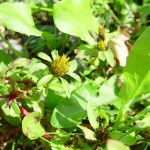| Common Name: |
Trifid bur marigold |
| Other Names: |
Water agrimony |
| Botanical Name: |
Bidens tripartita |
| Genus: |
Bidens |
| Family: |
Asteraceae |
| Native Location: |
Temperate Eurasia |
| Cultivation: |
Damp to wet soil in sun. |
| Propagation: |
By seed sown in spring. |
| Harvest: |
Plants are gut as flowering begins and dried for use in infusions, liquid extracts, and tinctures. |
| height: |
15-60cm (6-24in) |
| Width: |
10-30cm (4-12in) |
| Hardiness: |
Hardy |
| Parts Used: |
Whole plant |
| Properties: |
A bitter, astringent, diuretic herb that controls bleeding |
| Medicinal Uses: |
Internally for blood in the urine, uterine bleeding, ulcerative colitis, and peptic ulcers. Externally, in Russia, for hair loss. Combined with Acorus calamus (see sweet flag) or Zingiber officinale (See ginger) for digestive tract complaints, and with Agrimonia eupatoria (See agrimony) to control hemorrhage. |
| Bibliography: |
Encyclopedia of Herbs by Deni Brown. Copyright © 1995, 2001 Dorling Kindersley Limites. pg 144.
|

